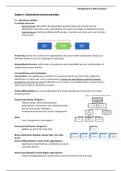Samenvatting
Samenvatting HRM & Management, ISBN 9789001850227 (Nick van Dam)
- Instelling
- NHL Stenden Hogeschool (NHL)
Een uitgebreide samenvatting van HRM & Management van de hoofdstukken 9,10,6,7,1 en 2. De gehele samenvatting is in het Engels.
[Meer zien]














